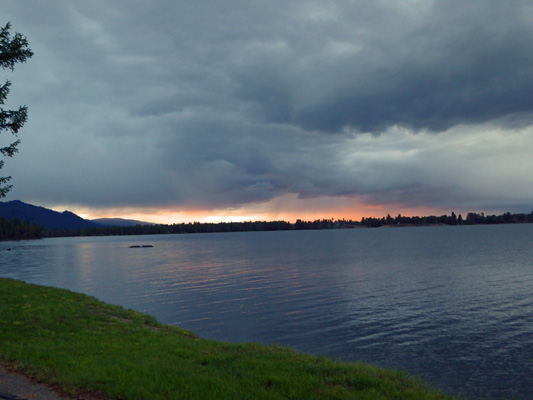
We awoke on Monday May 23rd to sunshine and we actually turned the heaters off for a while that morning because of solar gain. We did chores around the campground and checked in some folks from Oregon into one of our waterfront campsites. By late morning, the clouds were coming back in and I headed up to Donnelly to do the laundry. The Laundromat has WiFi so I happily updated Windows and Norton (and our website) all while getting all our clothes clean too. Such a deal. I had the place to myself which makes things all the more wonderful.
On the way back, I noticed a nice patch of Common Camas (Camassia quamash) growing next to the bike path that parallels the road. I pulled over, climbed down through a ditch and then up over the bike path. It was worth it though. Camas tends to grow in wet places so it was nice not to have to slog through a wetland to get to it.
Down on my knees I realized that if I just twisted around and down a bit more I could get the mountains in the photo too.
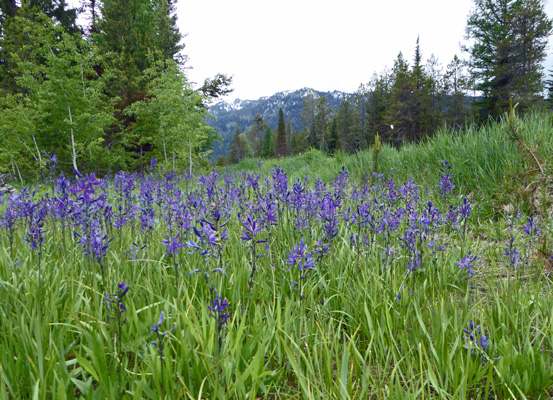
Nice stuff, camas.
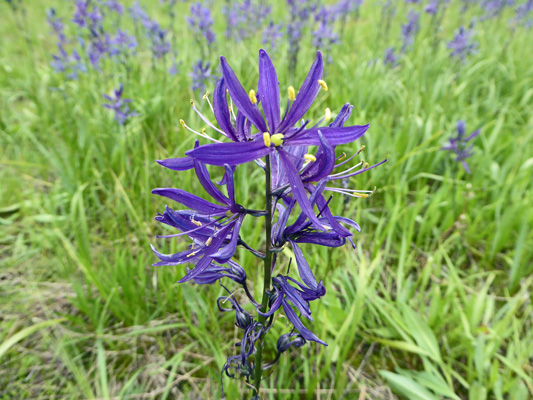
Since things are just a bit slow around these parts, I decided now would be a good time to take you on a tour of Huckleberry Campground.
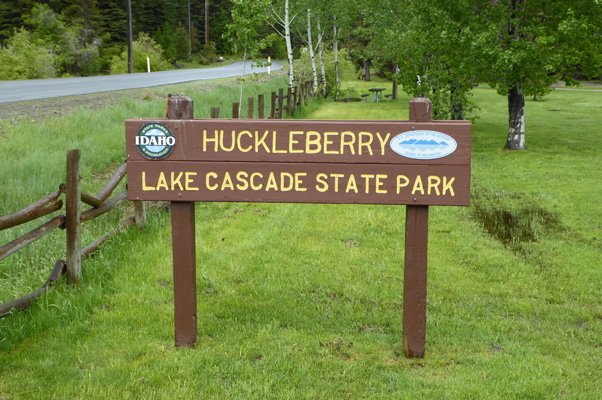
Huckleberry (and all the other 10 campgrounds at Lake Cascade State Park) was developed by the Bureau of Reclamation—the folks who built the dam that creates Lake Cascade. They contract with the state of Idaho to run the campgrounds so the state park actually sits on federal land.
To enter the campground you turn off of West Mountain Road and clatter your way over the cattle guard.
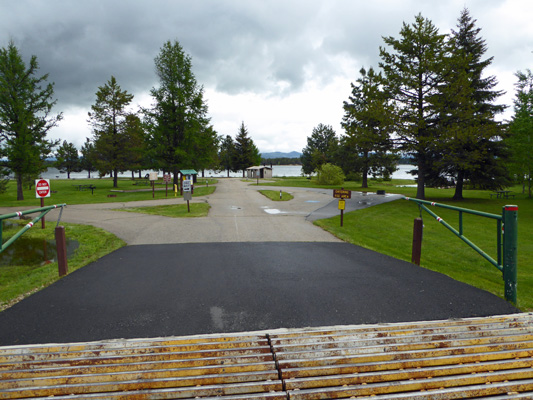
The road through the campground is one way and takes you counter clockwise around a loop. I took a panorama shot from the edge of the black entry pavement just to give you a taste of this end of the place.

There is a pay station on the left just as you start the loop. This campground has both single and companion sites (doubles) which just adds to the fun for folks trying to figure out what they owe. Once again this year, out of state visitors pay $3 (plus tax) more than the instate folks and everyone has to pay a $5 per car per day fee unless they have an Idaho Parks sticker. A basic site here (without the car fee) is $14.84 for instate folks and $18.02 for out of state folks.
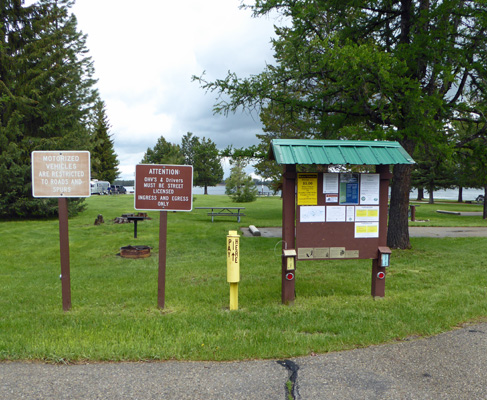
We have back-in sites like this one. This is site 79 and it’s a favorite because it’s right on the water and it’s right next to the bathrooms.
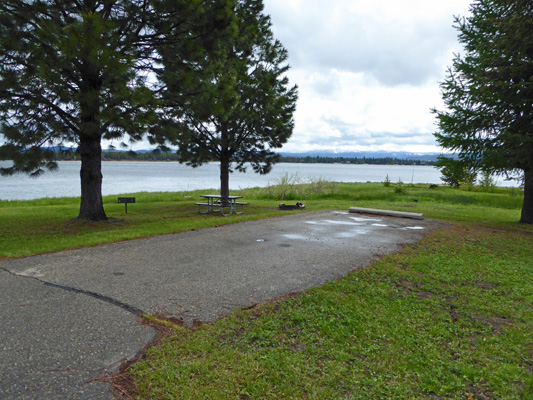
The bathrooms on this end of the campground are single occupancy uni-sex CRX outhouses. You can see them from the road and we have lots of folks drive in and use them and then drive through the loop and on out again.
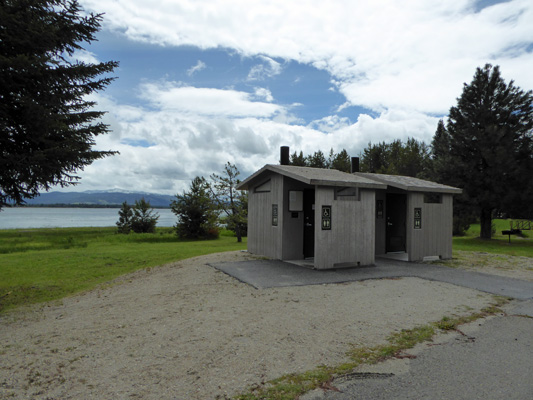
We also have a number of side pull-through sites.
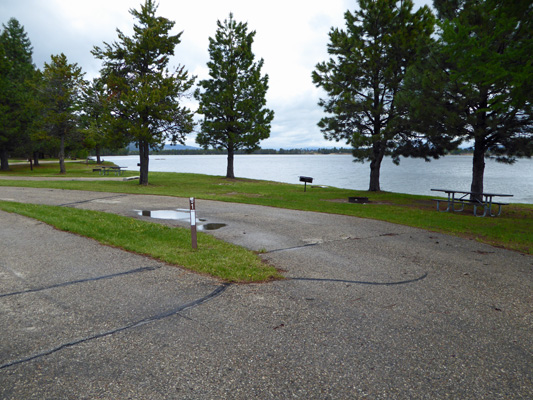
Once again, the ones on the lake side of the loop are real popular because your picnic table and fire circle are right there on the water.
All the sites come with a fire ring with a grill.
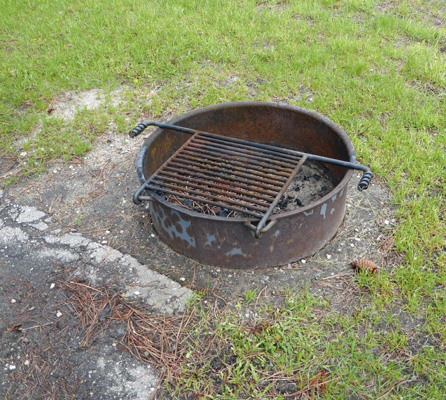
And most of them come with a upright grill too—great for charcoal.
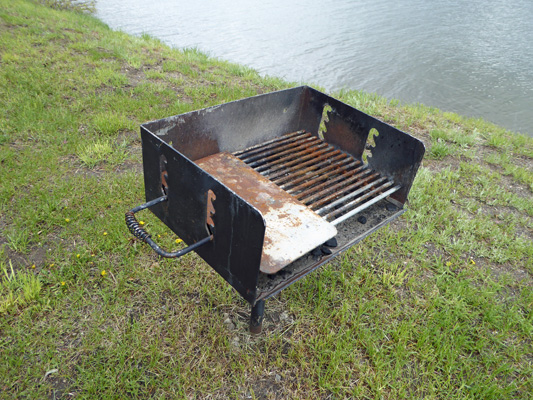
Now who wouldn’t want to have their campfire and roast their marshmallows at this fire ring?
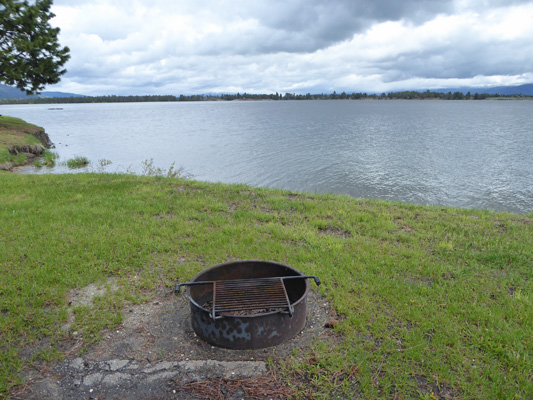
The only hitch is that there’s a drop off that is pretty abrupt so you need to be careful.
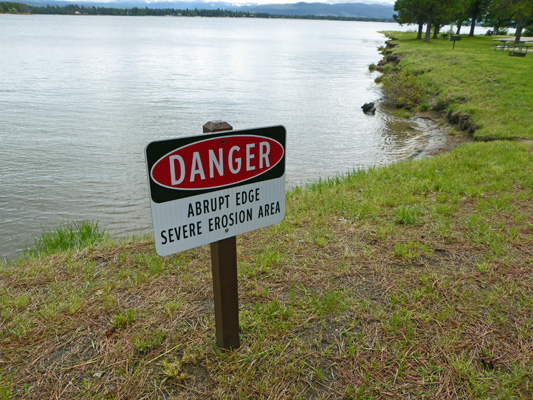
They had a pretty severe winter here this past year and there’s been a lot of erosion—chunks of green grass have fallen off onto what will be beach come July.
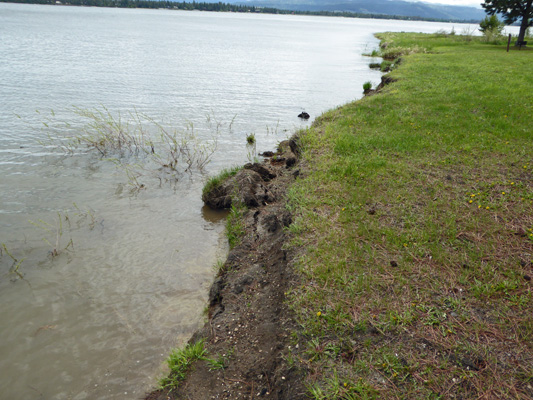
The road continues on to our site which is on the left side of the road.
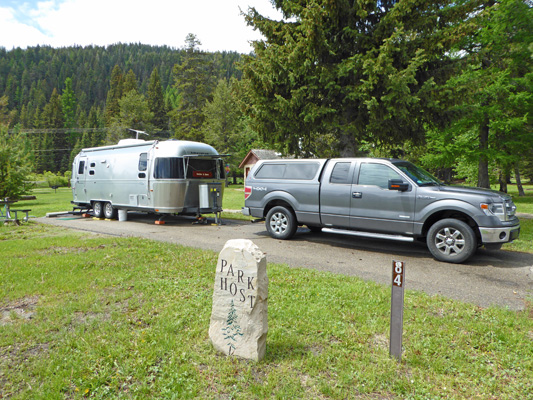
We have a great view of the campground from our kitchen table. Walter can actually see the lake from his seat and from where I sit, I can see out the bedroom windows to see the lake too .

The view from our patio area is lovely too.

Once again, we have the firewood bin in front of our site. You get a bundle of about 5 good-sized pieces of wood for $5. This bin collapsed over the winter and they had to reconstruct it last week. It needs a coat of paint—I’m just waiting for a couple of dry days before I do it.
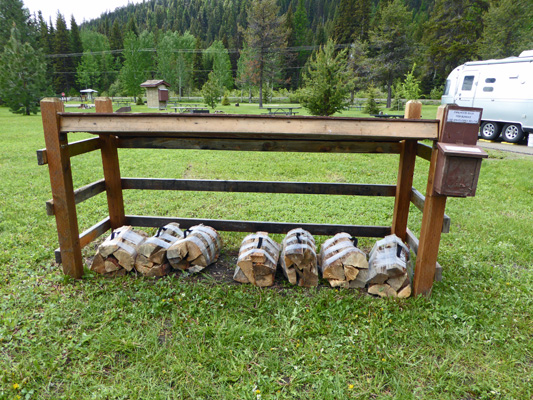
You continue up the loop a bit into the treed end of the campground, and site 87, our other very popular site. This one has a view of the lake and shade—something that is very valuable come summertime.
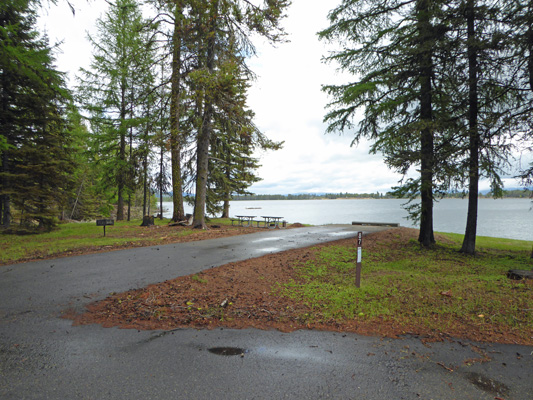
If you turn around from here you get a view of the rest of the campground. Oh goodie, grass to water! Of course at the moment things are plenty wet so we don’t have to worry about watering for a while.
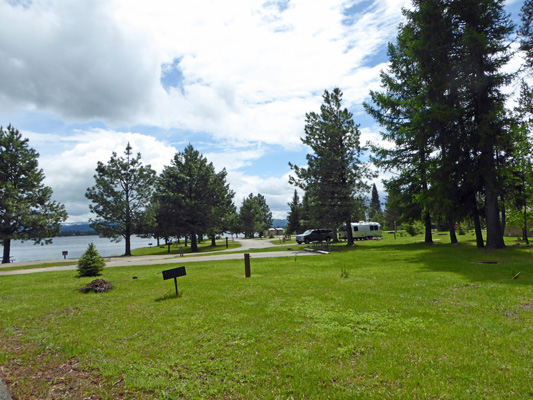
We also have five companion sites—double wide sites that come with two picnic tables. You can have 2 cars, 2 RVs and 4 tents with up to 16 people at a site like this.
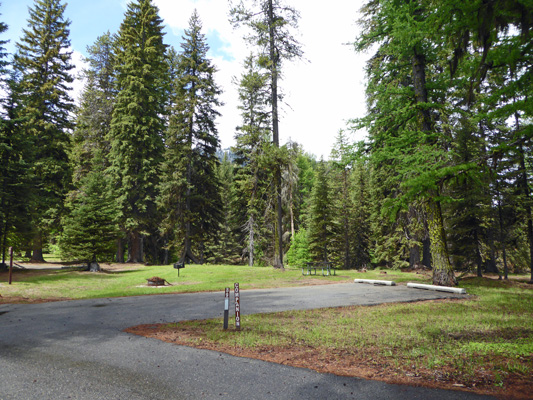
This site backs up on the inlet on the north end of the campground.
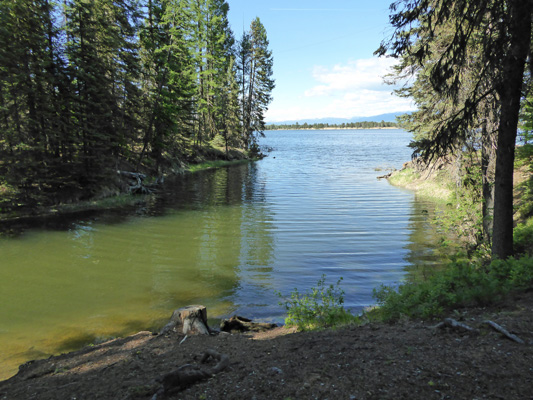
The loop continues on through the woods. We have about 12 sites that are in the shade and these tend to be popular in the summertime.
Here’s a view looking back towards the treed sites from along the loop.
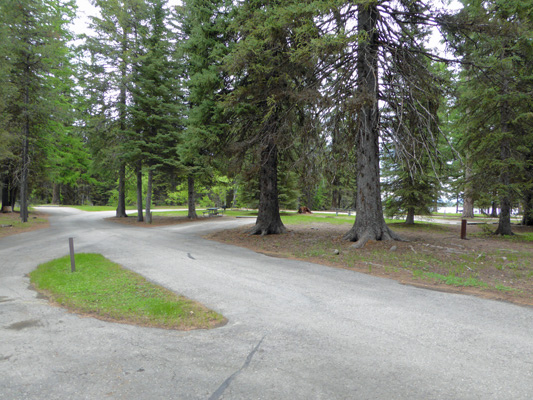
Our least popular sites are the ones out in the sun next to the road just before you reach the exit. They will be full most weekends but are rarely used during the week.
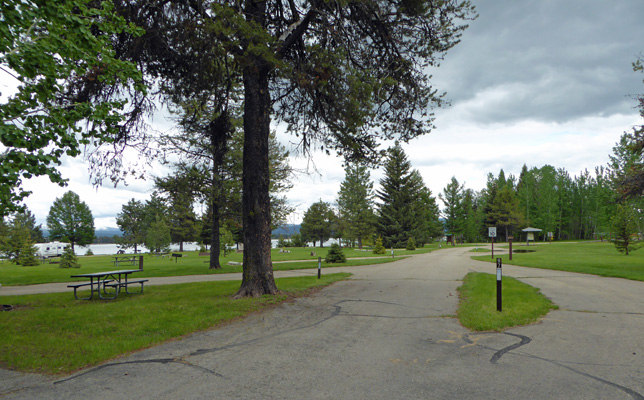
In the center of the campground, not far from our host site, is the main bathroom. It has a men’s and women’s bathroom each with 2 stalls. There’s no running water in the bathrooms—which sometimes is a shock to folks. You get to wash you hands at one of the nearby water spigots. Our seasonal employees clean our bathrooms every day all summer and keep them clean and smelling wonderful.
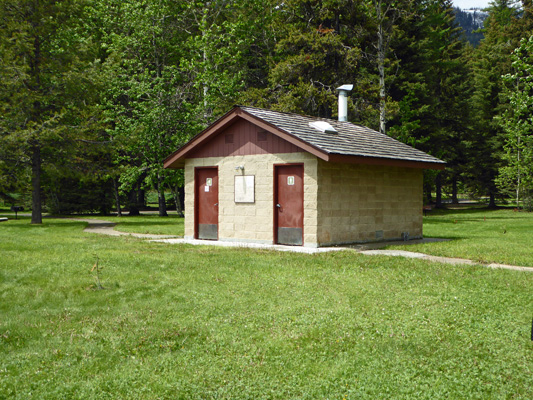
The campsites in Huckleberry are all un-serviced sites (except our host site which has a full hook up). There are 9 water spigots distributed through the campground to provide potable water to all the campers.
Here and there in the grassy areas of Huckleberry, you’ll find little trees marked by stakes so that the mowing crews won’t decapitate them. Some of these are Ponderosa Pines, some are white pines and there are a few larches too—all planted in an effort to provide shade to future generations of campers. We also have a lot of trees in the grassy areas that are about 6 feet tall—the previous generation of little trees in the grass.
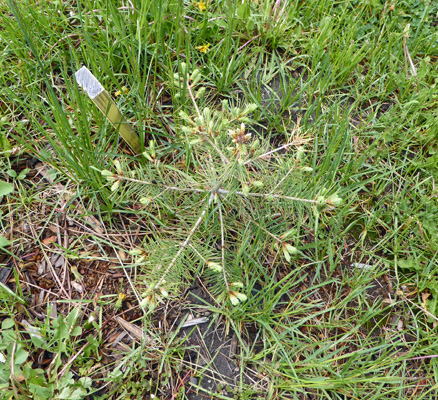
Back at the south end of the campground there’s a nice little bridge that goes over a slough.
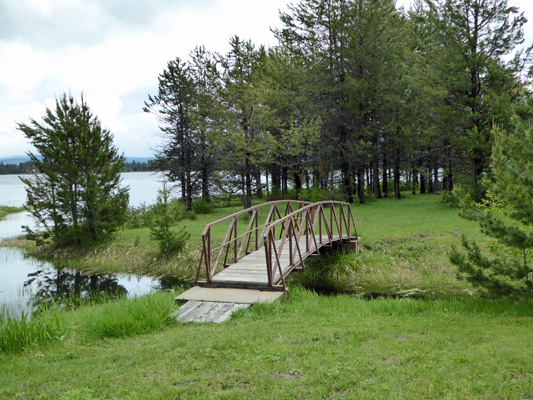
If you follow the trail from here you end up at Curlew, our tent only campground (which has its own entrance on West Mountain Rd). This is a first-come-first-served campground with 5 un-numbered sites. It only costs $10.60 a night (without the car fee) and while many weekends there is no one in it, on busy weekends there is a mad scramble to get a spot here.

Tent sites are inside the log barrier. There are 5 fire circles and 5 picnic tables. There’s some shade and water access, so it’s a real deal for tent campers. There’s also a pair of CRX outhouses like the ones on the south end of Huckleberry and two water spigots.
Curlew has a large population of ground squirrels who have left the place riddled with mounds of dirt.
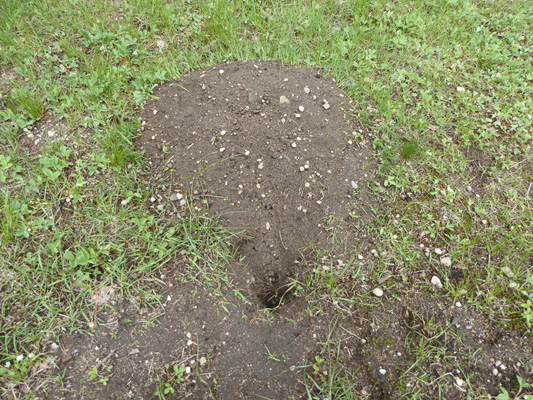
The good news is that most of the holes are at an angle so it’s hard to accidently step into one.
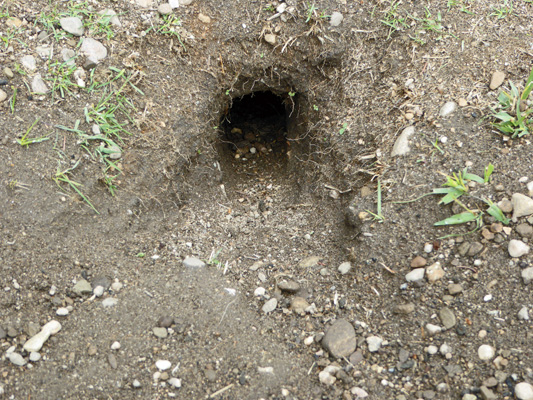
Filling them in is a losing battle since there’s an active population of squirrels who tend the burrows full time.
Now at least you have a bit of an idea of where we’re hanging out for the summer. It’s not the same as being here but hey we do the best we can.
On Monday evening, we noticed a bird off in the distance that we couldn’t identify from the trailer. So I got out my camera and hiked down to the south end of the campground to see what I could see. What I found was a pair of Common Mergansers—the female with the red head was sitting on a stump and the male with a black head was in the water.
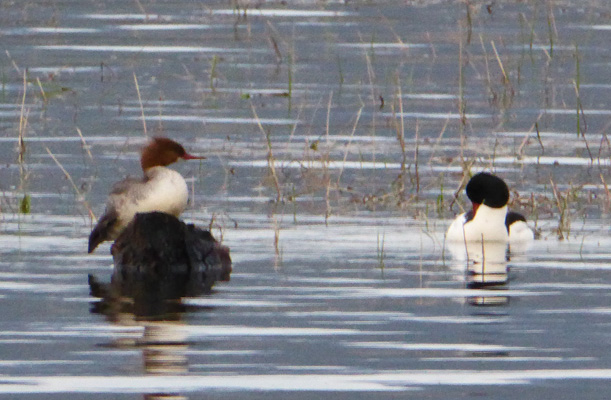
And further over on the shore I spied a pair of wood ducks. The males have really cool markings.
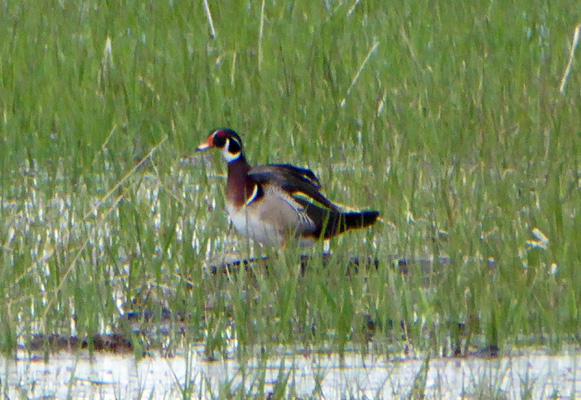
They got into the water as I was trying to snap photos of them. I took this with my 30x zoom lens fully extended with low light (it was early dusk) so I’m amazed it came out at all.

While we still had clouds, they had at least lifted enough so you could see the mountains again.
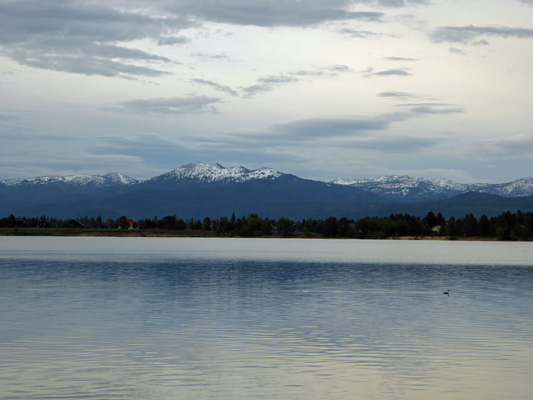
And there were some Western Grebes out on the glassy lake too.
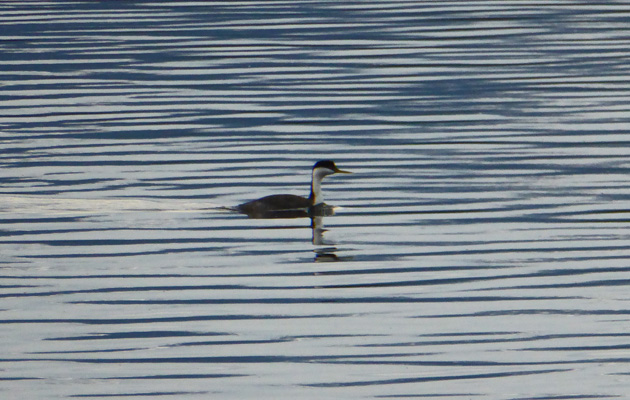
The next morning, the lake was still like glass—with clouds scuttling along mirrored in the lake’s surface.
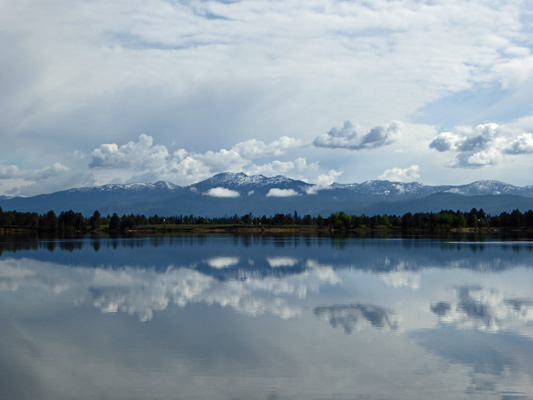
With fresh snow down below 7,000 feet, we opted to take a hike in the immediate area rather than trying anything up at any altitude. We drove around the lake to Crown Point which is just north of the town of Cascade and took the Crown Point Trail—an old converted railroad grade.
It’s a sandy trail but even then, it was pretty full of puddles. But there was always a way to get around them so we kept on keeping on. There was what looks like Taper-leaf Penstemon (Penstemon attenuatus) in bloom here and there along the way.
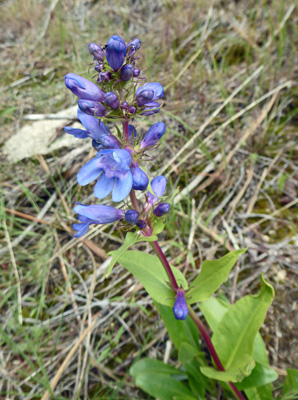
From time to time the trees opened up and you got a view cross the lake. This is at the north end of Crown Point Campground.
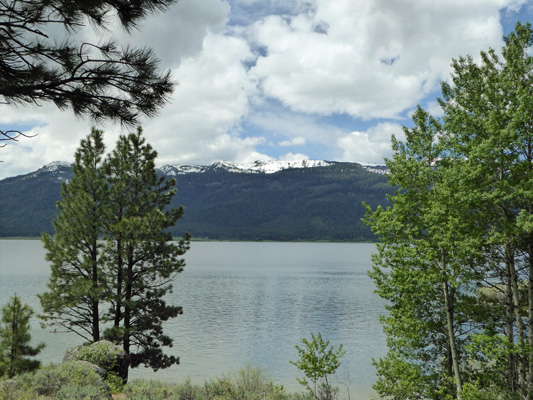
East of the trail there’s a big new house with a view.
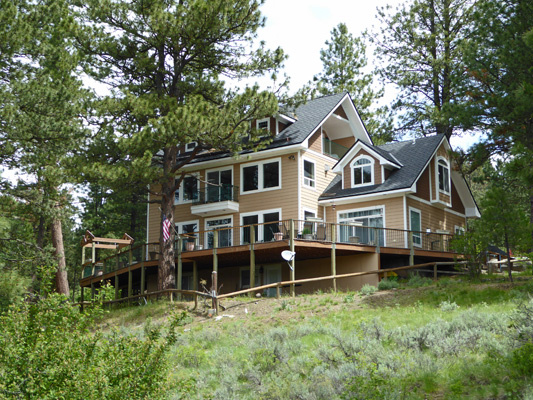
There was tons of very fragrant bitterbrush (Purshia tridentata) in bloom along the trail.
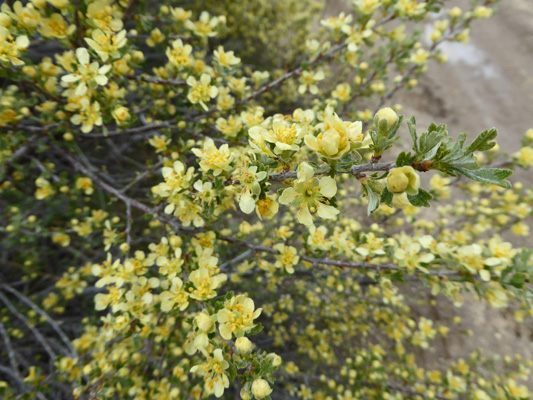
The trees open up and give you a nice view northward along the lake. You can see too that the trail was more than a little wet.
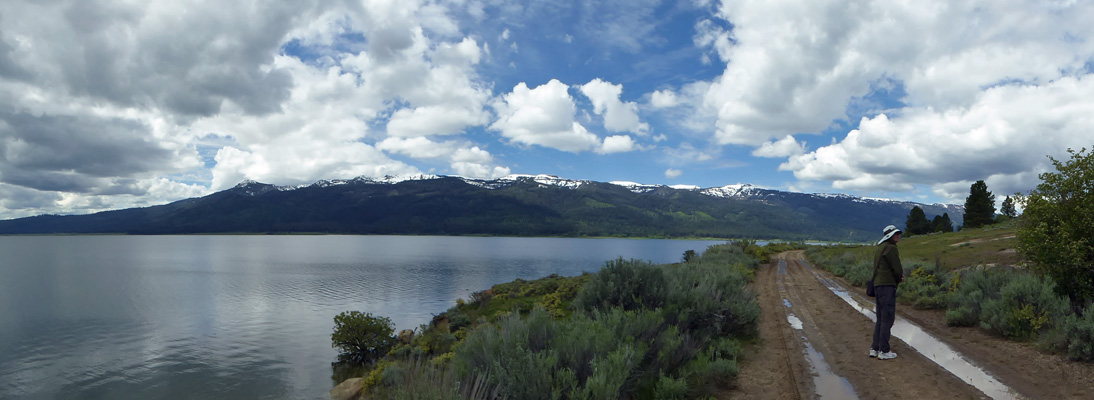
There were a few lupine in bloom in amongst the bitterbrush.
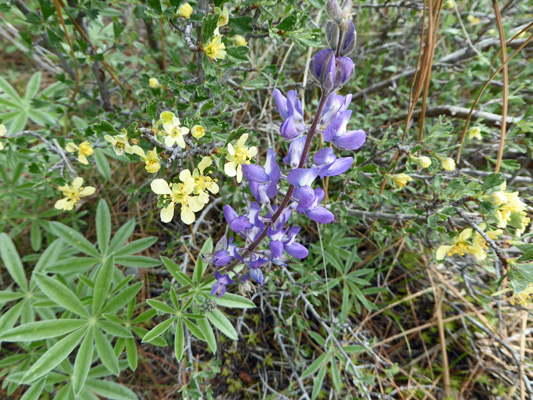
And in among the rocks on the hillside and on the lakeshore there was a new flower for me: Hot-rock Penstemon (Penstemon deustus).
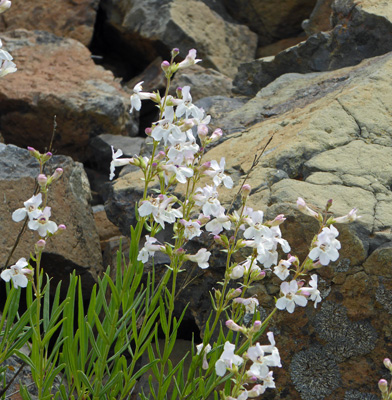
The mountains to the west still have LOTS of now.
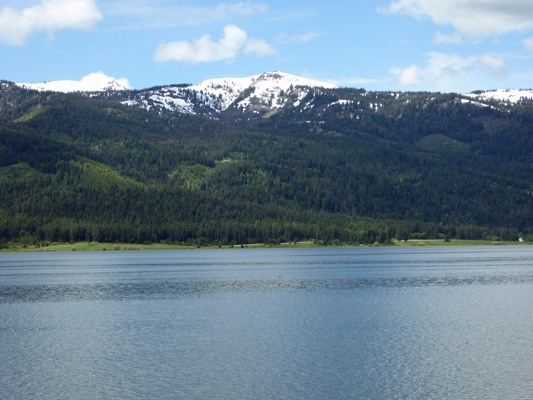
Just before we reached the one-mile marker we took a side-trail UP the hill to find the largest (and probably oldest) Ponderosa Pine of the area. This big old guy, is over 20 feet around. With all the underbrush we couldn’t get close enough to hug it so you don’t get Walter standing next to it to give it scale. But it’s an old tree—note the double crown and how much of that is dead.
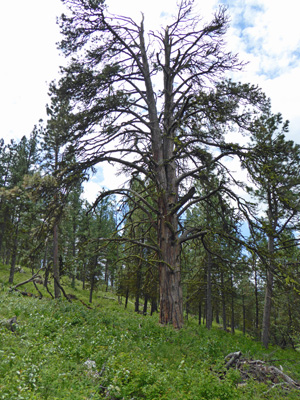
We sat on a log pile (there was a crew of kids working in the Conservation Corps who came through last summer and did some thinning of the forest for fire prevention and there are lots piles of logs and slash about) and enjoyed the forest. I noticed movement in one of the slash piles and zoomed in on a chipmunk. He had 2 other friends running around in the pile too.
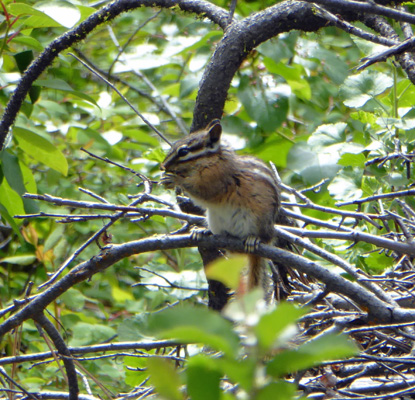
We hiked on back down the hill and then on past the one-mile marker. The mosquitos had been thick here and there but once we got out past the one-mile marker they got horrendous. I’d never had them try to get behind my glasses before. Ugh. The trail was really muddy and with the bugs we decided we were ready to turn around.
On the way back, Walter spied a frog—much bigger than the little guy we saw last week at Huckleberry. Don’t you just love the yellow stripe down his back.
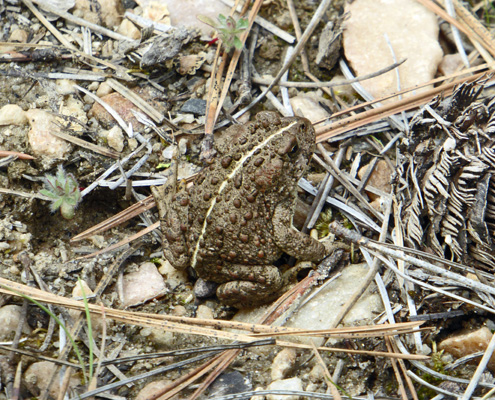
Here and there we saw butterflies visiting the flowers along the trail. This one was resting near a puddle in the trail itself.
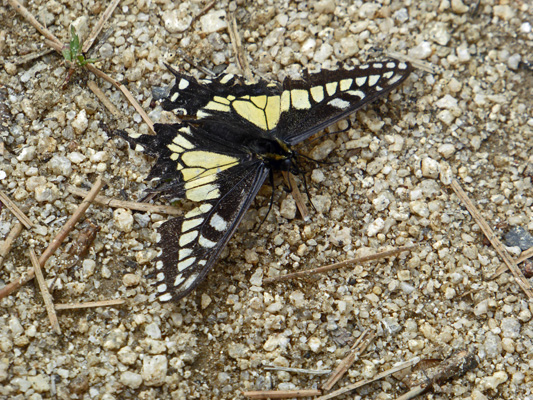
I saw two patches of Foothill Death Camas (Toxicoscordion paniculatum). Don’t eat the roots!
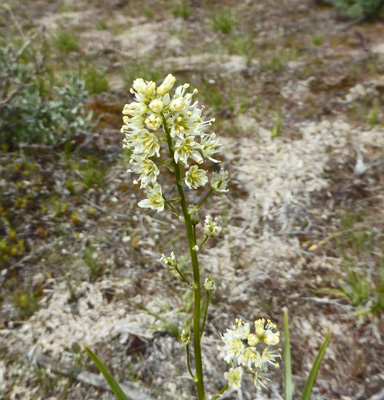
Back near the Crown Point Campground we found a nice bench where the mosquitos weren’t too bad and sat down to enjoy the view. And I spied a ladybug resting on some sage. There is much more sage on the east side of the lake than on the west—and we have no bitterbrush at all that I’ve seen over on the west.
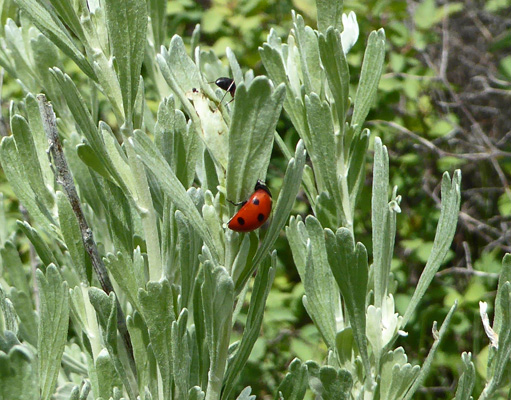
And there were a few Western Chokecherry (Prunus virginiana) in bloom next to the campground.
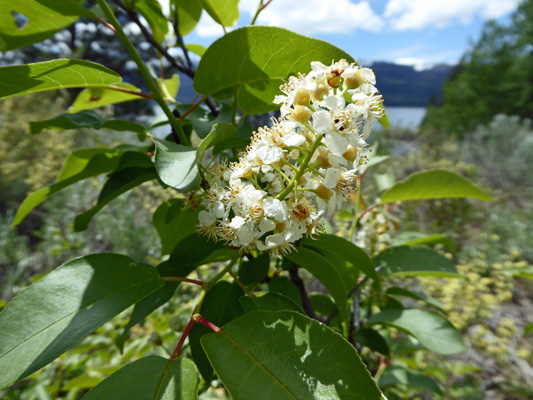
And a serious patch of fungus in the trail.
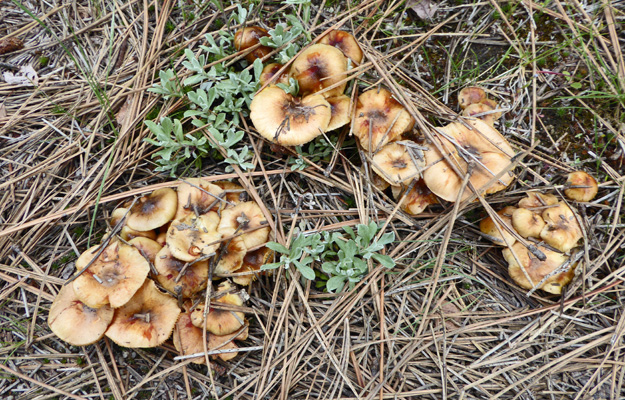
We climbed back into the truck at the trailhead and drove on through the campground to find a spot for lunch. On the north end of the campground there was a spot with a table out on the rocks and we sat in the sun and enjoyed the view with our lunch.

Tuesday evening Mother Nature put on a bit of a show lighting up the snow to the east a nice pink and then the clouds too.

And to the northwest things were peach.
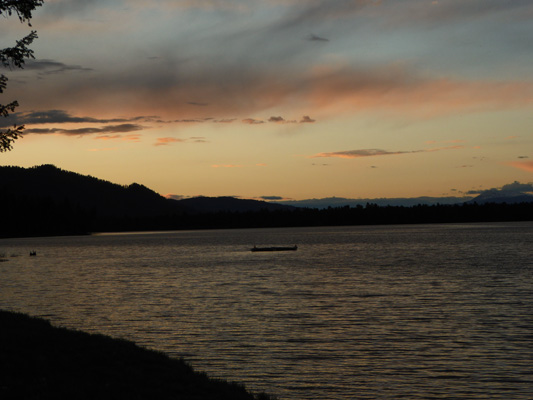
Wednesday we made our weekly trip to McCall for groceries and stopped for lunch at “My Father’s Place” the local hamburger joint where there is ALWAYS a line. I had halibut and chips and Walter had their Super Burger (ham and cheese on a 1/4 pound burger) and we waddled out having eaten too many very good homemade fries. When we got home, I started hearing this strange metallic tapping/banging noise. I couldn’t locate it and since it went away I forgot about it.
Thursday we spent the day doing last-minute chores around the campground to get it ready for the Memorial Day holiday weekend. Noble beings that we are, we swept and scrubbed all the picnic tables (lots of pollen and bird poop) and cleaned out all the fire rings. Sitting inside after lunch we heard the noise again and Walter pointed out it’s source—a woodpecker pounding on a slightly loose metal sign out on the road near our campsite. I went out with my wonderful new zoom and got a photo of him as he prepared to tell the world about his glorious territory.
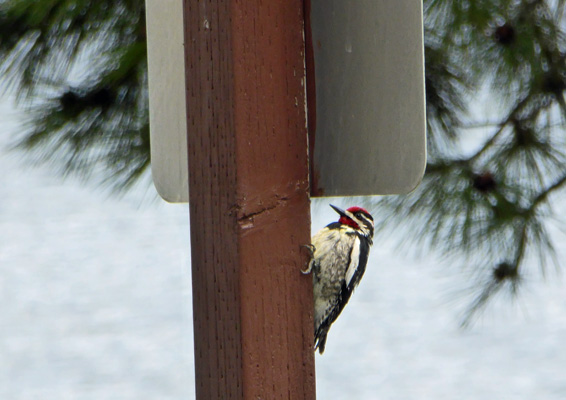
According to my bird book, this is a Red-naped Sapsucker—a close relative to the yellow-bellied sapsucker you find in the Pacific NW. He’s clearly wanting the world to know about his territory. We’ve heard him banging on hollow trees across the road and I saw him in the evening next to one of our campsites, pounding away on a tree trunk.
Friday the campground began to fill up in earnest. It was partly sunny but only in the high 50’s. A few folks chose to wait until Saturday to arrive (even though they had paid for Friday night) but all of them arrived by early afternoon on Saturday. We had huge herds of kids circling the campground on their bikes and stalking each other with water pistols. The kids came in all sizes but mostly they were pretty little.
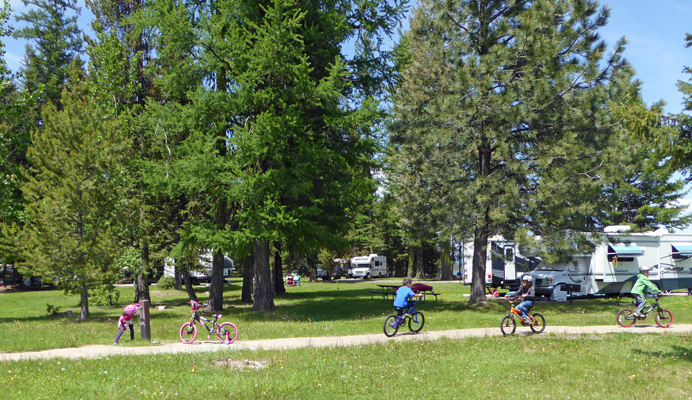
Here’s what our view out of kitchen windows looks like when the campground is full—there’s a double site there in the middle with 4 big tents on the grass but most folks are in trailers (pop ups to big 5th wheels) or RVs.

While we weren’t full on Friday night we had reservations for all our sites for Saturday and Sunday nights. We had a couple of no shows each night so we were never entirely full.
Saturday evening we had an unleashed pit bull (“she was only off the leash for a moment to get closer to the fire because it was cold”) dash out of her own campsite and down the road a bit to attack and 10-year-old bloodhound (with very few teeth left). The bloodhound’s owner managed to get them separated but his dog ended up with a very bloody ear (long teeth gouges all along the looooong bloodhound ear). Our rangers arrived just after it happened so they got to handle the upset bloodhound owner and then give the pit bull owner a citation. She was unhappy getting the citation, arguing that other dogs were off leash too (not so). But it was explained to her (over and over) that she was getting the citation because her dog attacked and bloodied another dog. I spent my time soothing the bloodhound’s owners and they decided to stay on through Sunday night. But the pit bull’s owner packed up and left on Sunday morning—too embarrassed to face a full campground atwitter about her dog or simply angry at getting a ticket. The parents of all those little kids in the campground were very glad to see her go.
